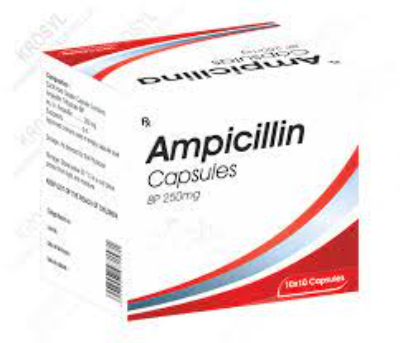


PO: 250-500 mg q6hr
IV/IM: 1-2 g q4-6hr or 50-250 mg/kg/day divided q4-6hr; not to exceed 12 g/day
Listeria endocarditis: 200 mg/kg/day IV divided q6hr; administer concomitantly with aminoglycoside for at least 4-6 wk
<40 kg: 50 mg/kg/day IV/IM divided q6-8hr
≥40 kg: 500 mg PO/IV/IM q6hr
<40 kg: 50 mg/kg/day IV/IM divided q6-8hr
≥40 kg: 500 mg IV/IM q6hr; larger doses may be necessary in severe or chronic infection
1-2 g IV q4-6hr with or without an aminoglycoside
3.5 g IV administered once simultaneously with 1 g of probenecid
150-200 mg/kg/day IV divided q6-8hr; initiate with IV infusion; may continue with IM injections if preferred; range 6-12 g/day
Maternal dose for neonatal prophylaxis
2 g IV initially, followed by 1 g q4hr until delivery
2 g IV q4hr
Take oral dosage form on empty stomach
Erythema multiforme
Exfoliative dermatitis
Rash
Urticaria
Fever
Seizure
Black hairy tongue
Diarrhea
Enterocolitis
Glossitis
Nausea
Oral candidiasis
Pseudomembranous colitis
Stomatitis
Vomiting
Agranulocytosis
Anemia
Hemolytic anemia
Eosinophilia
Leukopenia
Thrombocytopenia purpura
Anaphylaxis
Aspartate aminotransferase increased
Interstitial nephritis
Laryngeal stridor
Serum sickness-like reaction
Hypersensitivity
Use caution in allergy to cephalosporins, carbapenems
Adjust dose in renal failure; evaluate rash and differentiate from hypersensitivity reaction
Endocarditis prophylaxis: Use only for high-risk patients, per AHA Guidelines
Prolonged use associated with fungal or bacterial superinfection
Rash has developed during therapy in high percentage of patients with infectious mononucleosis receiving ampicillin class antibiotics; avoid therapy in these patients
Pregnancy category: B
Lactation: Excreted in breast milk; use caution
A: Generally acceptable. Controlled studies in pregnant women show no evidence of fetal risk.
B: May be acceptable. Either animal studies show no risk but human studies not available or animal studies showed minor risks and human studies done and showed no risk.C: Use with caution if benefits outweigh risks. Animal studies show risk and human studies not available or neither animal nor human studies done.
D: Use in LIFE-THREATENING emergencies when no safer drug available. Positive evidence of human fetal risk.
X: Do not use in pregnancy. Risks involved outweigh potential benefits. Safer alternatives exist.
NA: Information not available.
Broad-spectrum penicillin; interferes with bacterial cell wall synthesis during active replication, causing bactericidal activity against susceptible organisms; alternative to amoxicillin when unable to take medication orally
Peak plasma time: 1-2 hr (oral)
Bioavailability: 30-40%
Protein bound: 15-25%
Blister and tissue fluids, bile, and CSF with inflamed meninges
Liver
Half-life: 1-1.8 hr (normal renal function); 7-20 hr (anuria/end-stage renal disease)
Excretion: Urine (90% within 24 hr)
Solution: Dextran and dextrose solutions, LR, Ringer's, Na-bicarb, Na-lactate 1/6 M, IV fat emulsions, invert sugar solutions
Additive: Amikacin, aztreonam(?), cefepime(?), chlorpromazine, dopamine, gentamicin, heparin(?), hydralazine, hydrocortisone, prochlorperazine,
Syringe: Erythromycin, gentamicin, hydromorphone, kanamycin, lincomycin, metoclopramide, polymyxin B SO4, streptomycin
Y-site: Amphotericin B cholesteryl SO4, Ca gluconate, cisatracurium (at high cisatracurium concentration; may be compatible at low concentrations), diltiazem, epinephrine, fenoldopam, fluconazole, hydralazine, midazolam, nicardipine, ondansetron, sargramostim, verapamil, vinorelbine
Solution: NS (some contrary reports)
Additive: Clindamycin, erythromycin, floxacillin, furosemide, metronidazole, verapamil
Syringe: Chloramphenicol, colistimethate, heparin, lidocaine
Y-site (partial list): Acyclovir, aztreonam, clarithromycin, cyclophosphamide, esmolol, famotidine, heparin, labetalol, linezolid, KCl, MgSO4, meperidine, propofol, vancomycin, vitamins B/C
Reconstitute with sterile water for injection or bacteriostatic water for injection
Use 5 mL for 125 mg, 250 mg, or 500 mg vials; 7.4 mL for 1 g vials; or 14.8 mL for 2 g vials
Use initial dilution within 1 hr
Give direct IV over 3-5 min for (125-500 mg) and over 10-15 minutes for larger doses (1-2 g)
Do not exceed a rate of 100 mg/min
For intermittent infusion, dilute in 50-100 mL of NS and give over 15-30 min
Give IV intermittently to prevent vein irritation (change site q48hr)